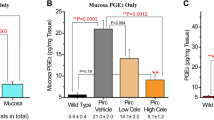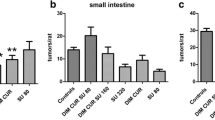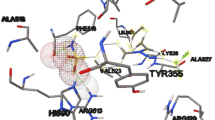Summary
DMU-135 (3,4-Methylenedioxy-3′,4′,5′-trimethoxy chalcone) is a novel anticancer prodrug designed to be activated into a potent tyrosine kinase inhibitor by the tumour selective enzyme activity of the cytochrome P450 enzyme CYP1B1. CYP1B1 is selectively expressed in a wide variety of tumours including colon. The hypothesis was tested that DMU-135 would inhibit ApcMin/+ mouse gastrointestinal adenoma formation. From 4–18 weeks of age animals received DMU-135 (0.2% w:w) in AIN93G diet. DMU-135 was well tolerated, induced no systemic side-effects and reduced adenoma multiplicity by 46 ± 18.3% compared to controls (p < 0.001). Further characterisation of this promising chemopreventive agent is required.
Similar content being viewed by others
References
Stoll R, Renner C, Hansen S, Palme S, Klein C, Belling A, Zeslawski W, Kamionka M, Rehm T, Muhlhahn P, Schumacher R, Hesse F, Kaluza B, Voelter W, Engh RA, Holak TA (2001) Chalcone derivatives antagonize interactions between the human oncoprotein MDM2 and p53. Biochemistry 40:336–344
Iwashita K, Kobori M, Yamaki K, Tsushida T (2000) Flavonoids inhibit cell growth and induce apoptosis in B16 melanoma 4A5 cells. Biosci Biotechnol Biochem 64:1813–1820
Lawrence NJ, McGown AT, Ducki S, Hadfield JA (2000) The interaction of chalcones with tubulin. Anticancer Drug Des 15:135–141
Potter GA, Butler PC, Wanogho E (2001) Chalcone Therapeutic Agents. British Patent Application GB 01/01341
Potter GA, Butler PC (2003) 3,4-Methylenedioxy Chalcones as Therapeutic Agents. GB 0123777.5 (2001), PCT:GB02/00406 (2002), WO 03/028713
Murray GI, Taylor MC, McFadyen MC, McKay JA, Greenlee WF, Burke MD, Melvin WT (1997) Tumor-specific expression of cytochrome P450 CYP1B1. Cancer Res 57:3026–3031
Stanley LA, Ball MT, Eaden J, Mayberry J, McKay H, Potter GA, Rolls S, Burke MD (2001) Cytochrome P450 CYP1B1 in the early stages of colon tumour development. Drug Metabol Rev 33:62
Gibson P, Gill JH, Khan PA, Seargent JM, Martin SW, Batman PA, Griffith J, Bradley C, Double JA, Bibby MC, Loadman PM (2003) Cytochrome P450 1B1 (CYP1B1) is overexpressed in human colon adenocarcinomas relative to normal colon: Implications for drug development. Mol Cancer Ther 2:527–534
Butler PC, Ruparelia KC, Ijaz T, Tan HL, Wilsher NE, Perry PJ, Burke MD, Potter GA (2003) DMU135: A CYP1B1 activated tyrosine kinase inhibitor prodrug with tumour selective activity. Br J Cancer 87:S33
Gibson P, Loadman PM, Shnyder S, Potter GA, Butler PC (2003) Bioavailability of novel anticancer chalcones in in vivo Xenografts. Br J Cancer 88:S27
Roberts RB, Min L, Washington MK, Olsen SJ, Settle SH, Coffey RJ, Threadgill DW (2002) Importance of epidermal growth factor receptor signaling in establishment of adenomas and maintenance of carcinomas during intestinal tumorigenesis. Proc Natl Acad Sci USA 99:1521–1526
Corpet DE, Pierre F (2003) Point: From animal models to prevention of colon cancer. Systematic review of chemoprevention in min mice and choice of the model system. Cancer Epidemiol Biomarkers Prev 12:391–400
Workman P, Twentyman P, Balkwill F, Balmain A, Chaplin D, Double J, Embleton J, Newell DR, Raymond R, Stables R, Stephens T, Wallace J (1998) United Kingdom Co-ordinating Committee on Cancer Research (UKCCCR) guidelines for the welfare of animals in experimental neoplasia. Br J Cancer 77:1–10
Luongo C, Moser AR, Gledhill S, Dove WF (1994) Loss of Apc+ in intestinal adenomas from Min mice. Cancer Res 54:5947–5952
Strumia MM, Sample AB, Hart ED (1954) An improved micro hematocrit method. Am J Clin Pathol 24:1016–1024
Goldstein NS, Armin M (2001) Epidermal growth factor receptor immunohistochemical reactivity in patients with American Joint Committee on Cancer Stage IV colon adenocarcinoma: Implications for a standardized scoring system. Cancer 92:1331–1346
Fischer OM, Streit S, Hart S, Ullrich A (2003) Beyond Herceptin and Gleevec. Curr Opin Chem Biol 7:490–495
Sansom OJ, Stark LA, Dunlop MG, Clarke AR (2001) Suppression of intestinal and mammary neoplasia by lifetime administration of aspirin in Apc(Min/+) and Apc(Min/+), Msh2(−/−) mice. Cancer Res 61:7060–7064
Perkins S, Clarke AR, Steward W, Gescher A (2003) Age-related difference in susceptibility of Apc(Min/+) mice towards the chemopreventive efficacy of dietary aspirin and curcumin. Br J Cancer 88:1480–1483
Perkins S, Verschoyle RD, Hill K, Parveen I, Threadgill MD, Sharma RA, Williams ML, Steward WP, Gescher AJ (2002) Chemopreventive efficacy and pharmacokinetics of curcumin in the min/+ mouse, a model of familial adenomatous polyposis. Cancer Epidemiol Biomarkers Prev 11:535–540
Sale S, Tunstall RG, Ruparelia KC, Potter GA, Steward WP, Gescher AJ (2005) Comparison of the effects of the chemopreventive agent resveratrol and its synthetic analog trans 3,4,5,4′-tetramethoxystilbene (DMU-212) on adenoma development in the Apc(Min+) mouse and cyclooxygenase-2 in human-derived colon cancer cells. Int J Cancer 115:194–201
Cortes J, O'Brien S, Quintas A, Giles F, Shan J, Rios MB, Talpaz M, Kantarjian H (2004) Erythropoietin is effective in improving the anemia induced by imatinib mesylate therapy in patients with chronic myeloid leukemia in chronic phase. Cancer 100:2396–2402
Dagher R, Cohen M, Williams G, Rothmann M, Gobburu J, Robbie G, Rahman A, Chen G, Staten A, Griebel D, Pazdur R (2002) Approval summary: Imatinib mesylate in the treatment of metastatic and/or unresectable malignant gastrointestinal stromal tumors. Clin Cancer Res 8:3034–3038
Sawaki A, Yamao K, Nakamura T, Suzuki T, Okubo K, Hara K, Kawai H, Yamamura Y, Ito S, Mochiduki Y, Ohno R (2004) A pilot study of imatinib mesylate (STI571) on gastrointestinal stromal tumors in Japanese patients. J Gastroenterol 39:329–333
Mahmoud NN, Carothers AM, Grunberger D, Bilinski RT, Churchill MR, Martucci C, Newmark HL, Bertagnolli MM (2000) Plant phenolics decrease intestinal tumors in an animal model of familial adenomatous polyposis. Carcinogenesis 21:921–927
Borrelli F, Izzo AA, Di Carlo G, Maffia P, Russo A, Maiello FM, Capasso F, Mascolo N (2002) Effect of a propolis extract and caffeic acid phenethyl ester on formation of aberrant crypt foci and tumors in the rat colon. Fitoterapia 73(Suppl 1):S38–S43
Liao HF, Chen YY, Liu JJ, Hsu ML, Shieh HJ, Liao HJ, Shieh CJ, Shiao MS, Chen YJ (2003) Inhibitory effect of caffeic acid phenethyl ester on angiogenesis, tumor invasion, and metastasis. J Agric Food Chem 51:7907–7912
Michaluart P, Masferrer JL, Carothers AM, Subbaramaiah K, Zweifel BS, Koboldt C, Mestre JR, Grunberger D, Sacks PG, Tanabe T, Dannenberg AJ (1999) Inhibitory effects of caffeic acid phenethyl ester on the activity and expression of cyclooxygenase-2 in human oral epithelial cells and in a rat model of inflammation. Cancer Res 59:2347–2352
Jacoby RF, Seibert K, Cole CE, Kelloff G, Lubet RA (2000) The cyclooxygenase-2 inhibitor celecoxib is a potent preventive and therapeutic agent in the min mouse model of adenomatous polyposis. Cancer Res 60:5040–5044
Frantz S (2004) Vioxx risk could signify trouble in class. Nat Rev Drug Discov 3:899–901
Author information
Authors and Affiliations
Corresponding author
Additional information
Grant support: Programme grant from the UK Medical Research Council and project grant from the Association for International Cancer Research
Rights and permissions
About this article
Cite this article
Sale, S., Tunstall, R.G., Ruparelia, K.C. et al. Effects of the potential chemopreventive agent DMU-135 on adenoma development in the ApcMin+ mouse. Invest New Drugs 24, 459–464 (2006). https://doi.org/10.1007/s10637-006-5947-0
Published:
Issue Date:
DOI: https://doi.org/10.1007/s10637-006-5947-0




